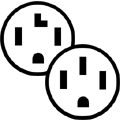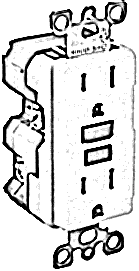National Electrical Code (US)
|
|
The National Electrical Code is Part 70 of a set of codes and standards set forth by the National Fire Protection Association (NFPA). It is comprised of a set of rules that when properly applied are intended to provide safe installation of electrical wiring and equipment. This standard governs the use of electrical wire, cable, and fixtures, and electrical and optical communications cable installed in buildings in the USA.
The reason for the National Electrical Code's existence is to codify the best practices of electrical work into a single, standardized source.
Most cities in the United States adopt the NEC as part of their municipal codes, as the authoritative set of rules for how electrical work is to be done. This means the NEC carries the force of law in many jurisdictions.
The NEC was developed by the NEC Committee of the American National Standards Institute (ANSI), was sponsored by the National Fire Protection Association (NFPA), and is identified by the description ANSI/NFPA 70-XXXX, the last four digits representing the year of the NEC revision.
The 110-year-old NEC is updated and published every 3 years. Recent publication dates were 1999, 2002 and 2005. Most municipalities adopt the most recent book within a couple of years of its publication. As with any "uniform" code, many jurisdictions regularly omit or modify some sections, or add their own requirements (sometimes based upon earlier versions of the NEC, or locally accepted practices).
In the U.S., anyone, including the city issuing building permits, may face a civil liability lawsuit (sued) for negligently creating a situation that results in loss of life or property. Failure to adhere to well known best practices for safety has been held to be negligent. This means that the city should adopt and enforce building codes that specify standards and practices for electrical systems (as well as other departments such as water and fuel-gas systems). This creates a system whereby a city can best avoid lawsuits by adopting a single, standard set of building code laws. This has led to the NEC becoming the de facto standard set of electrical requirements. A licensed electrician will have spent years of apprenticeship studying and practicing the NEC requirements prior to obtaining his or her license.
| Contents |
How The NEC Is Structured
The NEC is composed of an introduction, nine chapters, annexes A thru F, and the index. The Introduction sets forth the purpose, scope, enforcement and rules or information that are general in nature. The first four chapters cover definitions and rules for installations (voltages, connections, markings, etc), circuits and circuit protection, methods and materials for wiring (wiring devices, conductors, cables, etc), and general-purpose equipment (cords, receptacles, switches, heaters, etc). The next three chapters deal with special occupancies (high risk to multiple persons), specific equipment (signs, machinery, etc) and special conditions (emergency systems, alarms, etc). Chapter 8 is specific to additional requirements for communications systems (telephone, radio/TV, etc) and Chapter 9 is composed of ten tables regarding conductor, cable and conduit properties, among other things. Annexes A-F relate to referenced standards, calculations, examples, and additional tables for proper implementation of various code articles (e.g., how many wires fit in a conduit).
The introduction and the first 8 chapters contain numbered Articles, Parts, Sections (or Lists or Tables) italicized Exceptions, and Fine Print Notes (FPN) -- explanations that are not part of the rules. Articles are coded with numerals and letters, as ###.###(A).(#).(a) e.g., 804.22(C)(3)(b) could be read as "Article 804 point 22, section C, sub 3, item b." and would be found in Chapter 8. For internal references, some lengthy articles are further broken into "parts" with roman-numerals (Parts I, II, III, etc).
The NFPA also publishes a 1,100-page NEC Handbook (for each new NEC edition) that contains the entire code, plus additional illustrations and explanations, and helpful cross-references within the code and to earlier versions of the code.
Many NEC articles refer to "listed" or "labeled" devices, and this means that the device has been designed, manufactured and marked in accordance with its relevant standards. To be listed, the device has to meet the testing and other requirements set by a listing agency such as Underwriters Laboratories (UL) or Canadian Standards Association (CSA), with reference to appropriate testing standards. Only a listed device can carry the listing brand of the listing agency. To be labeled as fit for a particular purpose (e.g., "wet locations") a device must be tested for that specific use by the listing agency and then the appropriate label applied to the device (typically in addition to the listing marks).
Details of selected NEC requirements
Articles 210 addresses "branch circuits" (as opposed to service or feeder circuits) and receptacles and fixtures on branch circuits. There are requirements for the minimum number of branches, and placement of receptacles, according to the location and purpose of the receptacle outlet. A ground fault circuit interrupter (GFCI) is required on all outlets in bathrooms, outdoors and kitchens, and, in addition, for dwelling units: crawl-spaces, garages, boathouses, unfinished basements, and within 6 feet (1.8 m) of a wet-bar sink, with limited exceptions. See NEC for details. The NEC also has rules about such things as how many electrical sockets should be placed in a given residential dwelling per unit of floor area, and how far apart they can be in a given type of room, based upon the typical cord-length of small appliances (for example, not more than 12 feet apart, or 4 feet apart on kitchen countertops).
PolarizedOutlet.png
Polarized, grounded, 120-volt socket
As of 1999 the NEC required that new 120-volt household sockets, for general purpose use, be both grounded and polarized. NEMA has implemented this in its U.S. standard socket configurations so that:
- There must be a slot for a center-line, rounded pin connected to a common ground.
- The two blade-shaped slots must be of differing sizes, to prevent ungrounded (2-wire) devices which use "neutral" as their only ground from being misconnected.
The NEC also has provisions that permit the use of grounded-type receptacles in nongrounded wiring (for example, the retrofit of 2-wire circuits) if a GFCI is used for protection of the new outlet (either itself or "downstream" from a GFCI). Art. 406.3(D)(3).
The 1999 Code required that new 240-volt outlets be grounded also, which necessitates a fourth slot in their socket faces. U.S. 240 centertapped single phase has two of these slots being 'hot', with the neutral being the center tap. There is only one standard for these circuits, but 240 V sockets come in two incompatible varieties. In one the 'neutral' slot accepts a flat blade-prong. In the other the neutral slot accepts a blade with a right angle bend. These are officially NEMA types 14-50R (commonly used with number 8 wire for electric stoves) and 14-30R (commonly used with number 10 wire for electric clothes dryers), respectively, and differ only in current rating (50 A versus 30 A); previous installations would have used the 10-30 or 10-50 configuration.
These changes in standards often cause problems for people living in older buildings.
Unlike traditional circuit breakers and fuses, which only open the circuit when the "hot" current exceeds a fixed value for a fixed time, a GFCI device will interrupt electrical service when more than 4 to 6 milliamperes of current in either conductor is leaked to ground (either directly or through a resistance, such as a person). A GFCI basically detects an imbalance in the electricity (that is, a different amount of electricity flowing in the "hot" side than what is flowing in the "neutral" side). Socket outlets with GFCI have the added advantage of protecting other sockets 'downstream' of them, so that one GFCI socket can serve as protection for several conventional outlets, whether or not they are grounded. GFCI devices come in many configurations including circuit-breakers, portable devices and outlet receptacle sockets.
A GFCI socket typically has a pair of small push buttons between its two receptacles: one labeled 'test' and the other 'reset' (or T and R). Pressing 'test' will place a small imbalance in the line sensor, which will trip the device, resulting in an audible "snap". Pressing 'reset' will allow the socket to function normally after a test, or after a faulty appliance has been removed from the circuit or insulated from ground.
Like fuses and circuit breakers, a GFCI socket has a finite number of uses. It must be replaced when a test fails to trip the device.
See also
External links
- National Fire Protection Association web page (http://www.nfpa.org)


